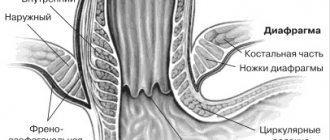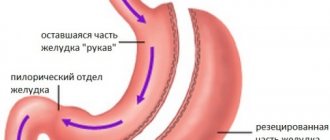The walls of the stomach consist of muscle tissue, and if it is frequently filled with large quantities of food, its volume will increase quite quickly. But the reverse contraction occurs for weeks. However, there are ways to reduce stomach volume naturally. Read about proven ways to reduce stomach volume here.
Are you overweight and trying to lose weight to no avail? Do you suffer from an unbearable feeling of hunger on any diet and therefore fail ahead of schedule? Perhaps the lack of results and the feeling of hunger are not due to food restrictions or poor diet. Very often, the real cause is a distended stomach , which causes a person to consume much more food than he needs for healthy functioning.
What should be the size of the stomach?
Experts say that the volume of 1 meal should not fill more than 2/3 of the entire stomach. The amount of fluid consumed also needs to be taken into account. A single meal should not exceed 650-700 g. An adult should consume about 1.5 kg of food per day. With such a volume, the stomach will not stretch and gradually increase in size.
There is a simple method for determining the normal size of the stomach. It is equal to two fists pressed tightly against each other. In this case, it is recommended to adhere to the norm of a single meal in volume equal to 1 fist.
What to do to eat less
In this section, we’ll talk about the most effective tips with which you can reduce the volume of your stomach. Experts advise hanging a mirror in the kitchen. But what does this have to do with overeating? In the course of ongoing research, scientists have found that eating in front of a mirror helps limit oneself from eating unhealthy foods.
Experts explain that when you see a fat man eating burgers or chips in the reflection, you feel ashamed of yourself. Scientists also noticed a direct relationship between excess weight and the method of payment for purchased products. The essence of this theory is that in the process of taking money out of their wallet, the buyer has time to think about the benefits of the chosen food.
Attention! Indian scientists have confirmed that the use of bank cards contributes to obesity.
Experts recommend cleaning the kitchen. Scientists have scientifically confirmed that a mess provokes a more negligent attitude towards the food consumed. You should also not forget about peppermint. A small bunch of this herb helps control sudden feelings of extreme hunger. Taiwanese scientists have concluded that eating with a long fork helps you lose weight. Short utensils scoop more food.
Experts recommend drinking water to lose weight and reduce stomach volume.
It has been proven that maintaining a drinking regime promotes weight loss. We are talking specifically about natural water, and not about juices and teas. To remember to drink fluids on time, place a bottle of water on your desk and drink a glass every hour. You can even set a reminder on your phone. For taste, you can add a little lemon juice.
Dieting is often associated with severe restrictions. Those who torment themselves with tasteless, monotonous food are more susceptible to eating breakdowns. Don’t mock yourself; among the low-calorie dishes you can find something that suits your taste. Experts note the relationship between successful weight loss and good sleep. If you want to reduce stomach capacity, you need to sleep for at least seven to eight hours.
Psychologists note that after eating a full plate, a person feels satisfied, and the size of the plate does not matter. You can use this trick by using a small plate. Scientists have found that the color environment affects appetite. Warm tones increase the desire to eat, while cold tones, on the contrary, reduce appetite. The strongest effect is produced by blue color. If possible, choose dishes of this color, as well as tablecloths and wallpaper in the kitchen.
Walking in the fresh air is known to increase appetite. Scientists have also found that intense walks at a fast pace saturate the body with oxygen and, conversely, contribute to dulling of appetite. Rid yourself of temptations. There should be no prohibited foods in your refrigerator! For snacks, use dried apricots, prunes, unsweetened apples, carrots, cucumbers, and tomatoes.
Proper snacks also include fermented milk products and protein shakes. Experts recommend regularly maintaining a vitamin and mineral complex. Some requests of our body may indicate deficiencies of a particular substance. For example, an increased need for sweets may indicate a lack of chromium, and an obsessive desire to eat chocolate indicates a lack of magnesium.
Don't eat in front of the TV screen
Avoid unconsciously eating in front of the computer or TV. Being distracted by events, you cease to control what, how and how much you eat. Make every meal a ceremony. Remember, the main thing is not quantity, but quality. If you want, for example, chocolate, then buy some quality product made from natural cocoa beans. This way you will satisfy the body's needs and at the same time not overload it with extra calories.
Why does the stomach stretch and what does it mean?
The stomach is anatomically capable of stretching in size, which leads to an increase in food intake. This causes weight gain. Why does the stomach stretch?
The following reasons lead to an increase in the size of the stomach:
- pathologies of the digestive system, most often the stomach;
- stress, depression and other nervous system disorders;
- a large amount of fatty, spicy foods eaten;
- the habit of drinking a lot of liquid during or immediately after meals.
In addition, the main reason is considered to be a violation of nutritional rules. First of all, overeating increases the size of the stomach.
Eating disorders:
Indications and contraindications
Gastric banding is recommended for:
- obesity with BMI ≥ 40 and ineffectiveness of conservative therapy;
- obesity with a BMI ≥ 35 and the presence of secondary concomitant pathologies - compensated diabetes mellitus, hypertension;
- ineffectiveness of diets and physical activity for weight loss.
In each specific case, the attending physician evaluates which treatment method is best for a particular patient. The choice depends on his general condition, age and pathogenesis of the disease.
Gastric banding is contraindicated:
- for severe pulmonary and cardiac pathologies;
- gastrointestinal dysfunctions;
- chronic infections;
- individual intolerance to the components of the bandage system;
- reluctance or inability to follow a diet in the postoperative period;
- blood clotting disorders;
- alcoholism, drug addiction;
- emotional instability;
- under the age of 18.
How to reduce the size of the stomach, methods
Depending on the amount of extra pounds and the presence of diseases, different methods are used to reduce the size of the stomach.
The most common methods:
- adjusting the regimen and volume of food consumed;
- special diet;
- medications that reduce appetite;
- surgical intervention;
- traditional methods;
- gastric fitness.
In order to achieve the desired result without harming your health, it is recommended to seek help from a specialist who will individually select the most effective way to solve the problem.
Exercises
The developed complex for reducing the volume of the stomach is aimed not only at strengthening the abdominal muscles, but also toning the small abdominal muscles and working out the diaphragm. Let's look at some effective exercises:
- dog breathing. You should sit in the half lotus position with a straight spine. You should alternately inhale and exhale with your stomach pulled up to your spine. It is better to first take three inhalations through the nose and then three exhalations through the mouth;
- plank Stand in a straight line, resting on your toes and palms. Take ten inhalations and exhalations alternately. Then pull your stomach in without changing your position. Finally, lift your buttocks up until your body is in an “L” position. Gently lift vertebra by vertebra;
- twisting Roll over onto your back and assume the half lotus position. Take a deep breath and exhale, and then strongly draw in your stomach. Try to stay in this position for a few seconds;
- screw. Get into a plank position and do ten dog breaths. Then draw in your stomach and, as you exhale, bring your right leg to your left shoulder. Stay in this position. The same steps should be repeated with the second leg.
There are also psychological benefits to losing weight through meditation. Adherents of this technique claim that the subconscious includes the strongest motivation to lose weight, the desire to love yourself and your body, and also break the barrier to slimness.
Experts also recommend performing breathing exercises. It helps cope with hunger, normalizes digestion and absorption of nutrients, and increases vitality. If you devote at least fifteen minutes a day to this, the results can be felt in about a month. It is best to do exercises in the morning on an empty stomach in front of a window or in the open air.
Let's consider a set of exercises for beginners:
- First, you should inflate your stomach and then draw it in through your nose. Count to four in your head. Until the sixteenth count, you should hold the air, fixing your stomach in a protruded state. On the count of eight, you should exhale slowly and at the same time draw your stomach in;
- On the count of four, inhale, hold your breath for four seconds and exhale for another four counts. It is necessary to do ten to twenty such repetitions;
- sit on a chair with a flat back. Keep your back straight, feet flat on the floor, and knees at a ninety-degree angle. Slowly draw in air and then exhale, pressing your stomach towards your spine;
- lie on the floor and bend your knees. Place one hand on your chest and the other on your stomach. As you inhale, press on the abdominal wall, and as you exhale, apply pressure to the chest wall.
Breathing exercises will help shrink your stomach
What complications exist and how to deal with them
Like any other surgical operation, sleeve gastroplasty can lead to certain negative consequences. These include the following.
- general surgical complications (thrombosis of mesenteric veins, suture failure, bleeding, wound infection);
- hiatal hernia;
- functional obstruction of the operated stomach due to its bending;
- hypovitaminosis B;
- heartburn;
- weight gain in the long term.
The surgeons at our clinic are aware of all possible complications and take measures to prevent them. During the operation, the quality and tightness of all surgical sutures are carefully checked, the rules of asepsis and antisepsis are strictly observed, and innovative methods of work are used. After the intervention, the patient receives antibacterial drugs and agents to prevent the occurrence of blood clots. All this allows us to reduce the percentage of complications to a minimum. To date, negative consequences are recorded in no more than 1-2% of cases. All of them are successfully eliminated by the center’s specialists.
In order to completely eliminate postoperative problems or provide timely assistance if they arise, we will observe you in the hospital for 4-5 days after the operation. If problems arise after discharge, you can always contact us to solve them. The Moscow Bariatric Group staff includes doctors of many specialties, so you can undergo a comprehensive examination and receive advice from an endocrinologist, nutritionist, surgeon and other specialists. Together we will definitely select the optimal treatment plan for your treatment.
How new is this operation?
Indeed, longitudinal (synonyms: reduction, sleeve, tubular, vertical) gastrectomy is a relatively new bariatric operation. I used the word “comparatively” because in fact, longitudinal gastrectomy (LG) is an integral part of the biliopancreatic bypass operation in the Hess-Marceau modification, known in the world since the early 1990s and successfully used in our clinic since 2003. Therefore, we can confidently say that the technical details of this operation have already been well worked out. However, as an independent operation, PRG was first performed in the USA in the early 2000s by M. Gagner et al. as the first stage of biliopancreatic bypass surgery in severely obese patients. The calculation was made to carry out the second, “intestinal stage” of biliopancreatic bypass, in the future, as the preliminary weight loss and improvement of the patients’ condition occurred. It later turned out that in some patients, PRJ turned out to be a completely self-sufficient operation to achieve the desired weight loss. Since that time, and this is only a little over five years ago, PRG began to be used in many foreign clinics, and then in our country, as an independent operation. In our clinic, prostate cancer was first performed as an independent operation in 2004.
Postoperative period:
Within 3 hours after the operation, the patient will be able to get up and drink water. The day after surgery, water, broth, and enteral nutrition mixture are allowed. All features of the early postoperative period are also discussed and discussed in a personal consultation with the surgeon before the operation.
Upon discharge, you will be given recommendations that you must follow. Your surgeon will tell you in detail about all the features of nutrition, physical activity, taking vitamins and follow-up visits.
The most important thing to understand is that you didn't just have bariatric surgery. You must understand that everything you did before surgery led you to the operating room. You will need to completely change your attitude towards food and change your habits.
We are ready to provide you with effective, highly qualified assistance in the fight against excess weight, but your role in this battle is the main one.
Preparation
First of all, it is important for the patient to realize that weight loss cannot be achieved solely through surgery: it will be necessary to change their lifestyle - eating habits and physical activity. In addition, surgical treatment does not provide immediate results. In order to convey key instructions to the patient, at the initial stage of preparation for gastric banding, work with a psychotherapist is indicated.
Then a standard and specific preoperative examination is carried out:
- consultation with a nutritionist - analysis of the diet before surgery and discussion of what it should be like after it;
- endoscopic examination of the stomach (or x-ray with barium) - to exclude the presence of ulcers, polyps, tumors;
- breath test for Helicobacter Pilori - a bacterial causative agent of stomach ulcers;
- ECG;
- fluorography;
- laboratory blood and urine tests;
- consultation with an anesthesiologist.
A month before surgery, you need to stop smoking: smoking reduces immunity, inhibits healing processes, and can provoke thrombosis and postoperative pneumonia. It is advisable to reduce your daily calorie intake in order to reduce excess weight by 5-10% - this will allow you to recover faster after surgery and increase its effectiveness. Learn to eat slowly - chew each lump of food at least 15 times; While chewing, do not hold the fork in your hand - put it on the plate. Avoid alcohol 2 days before surgery.
Surgery to reduce the volume of the stomach: benefits and harms
If diets and exercises do not bring the expected effect or you are unable to adhere to certain eating rules, then the only way to reduce your stomach size is through surgery . Such a radical method of treatment is considered extreme and is avoided in every possible way.
Gastric reduction surgery is a last resort
Surgical stomach reduction has its advantages:
- the patient loses weight quickly
- the load on the cardiovascular system and other organs is reduced
- general condition improves
I distinguish between the following types of surgical reduction of the stomach:
- bypass - creates a small reservoir in the stomach that can reduce a very small amount of food. In this case, food does not enter the main part of the stomach, but goes along a bypass route
Bypass surgery
- banding - placing a ring on the stomach, which tightens its cavity, forming two cavities of different sizes and a small gap between them
Bandaging
- ballooning - insertion of a balloon into the stomach, which fills a larger volume of the stomach, leaving a small space for food
Ballooning
- longitudinal resection - removal of the side of the stomach
Longitudinal resection
All of these methods can help eliminate excess weight, but they have their negative consequences . Often, an incorrectly performed operation can lead to the death of the patient; at best, you may encounter unpleasant disadvantages of such intervention in the body:
- sharp pain in the stomach area
- when the sutures diverge, peritonitis may develop
- long and difficult recovery period
- during ballooning, the balloon may burst and an operation will be performed to remove it from the stomach
- disorders of the gastrointestinal tract
- dumping syndrome, which is characterized by the occurrence of a number of symptoms after eating: rapid heartbeat, nausea, dizziness, tic
- inflammatory process
Gastric reduction surgery is a radical method that is best avoided. There are many ways to shrink your stomach without surgery, and it is better to show willpower, endurance and try diets, proper eating and drinking habits, and exercises than to risk your life and health on the surgical table.
Advantages and disadvantages of gastroplasty
Gastric resection is a proven and well-tested bariatric intervention by our surgeons. Its main advantages include the following points.
- High efficiency. Sleeve resection is significantly more effective than gastric banding, installation of an intragastric balloon and other methods of surgical treatment, second only to gastric bypass.
- Absence of foreign bodies in the body. After surgery, your body will no longer have silicone bandages and other devices that require further adjustment, and over time can lead to the development of complications.
- The physiology of digestion is preserved. Sleeveplasty does not change the path of food and digestive juices in the body. After the operation, the gastric sphincters are preserved, as well as the areas responsible for the absorption of vitamins. This reduces the risk of developing hypovitaminosis, protein starvation and other negative effects inherent in bariatric surgery on the intestines.
- type II diabetes mellitus The results of a study conducted by the American Society for Bariatric Surgery in 2015 showed that gastric sleeve surgery has comparable antidiabetic effects to Roux-en-Y surgery (gastric bypass). In patients who undergo this procedure, recovery is achieved in 70-80% of cases.
- Lifelong effect. In patients who follow dietary and lifestyle recommendations, the effect of the intervention lasts throughout life. There is no need for any further reconstruction.
The main disadvantage of sleeve gastroplasty is its irreversibility. It is no longer possible to restore the previous state of the stomach through surgery. It should be noted that there is usually no need for this, and if the diet is not followed, the stomach itself stretches over time and restores its normal volume. Another point to consider is the gradual “acclimation” of the baroreceptors of the stomach to increased pressure. At the same time, a person stops experiencing a constant feeling of fullness and begins to eat more food. There is a risk of weight gain again.










